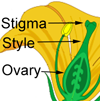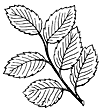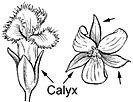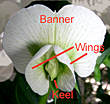Mamani
Sophora chrysophylla
Pea family (Fabaceae)
Native species ()
native tree or shrub widespread but mainly in dry mountain forests, identified by () leaves with mostly silvery gray showy golden yellow beanlike flowers, and distinctive 4-winged pod. Small to medium-sized tree 20–40 ft (6–12 ) tall and to 2 ft (0.6 ) in diameter, or a shrub. Bark gray brown, smoothish, becoming furrowed into scaly ridges. Twigs are hairy when young. Pea subfamily (Faboideae).
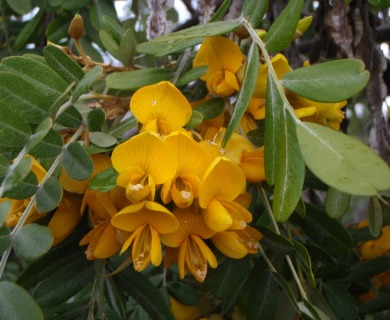
©2012 Eric White
Flower clusters () at ends and sides of twigs, unbranched, less than 2 inches (5 ) long. Flowers several on slender stalks, beanlike, 1⁄2–1 inch (13–25 ) long, golden yellow, consisting of cup shaped hairy less than 3⁄8 inch (10 ) long with short teeth, five yellow petals 1 inch (25 ) long, broad curved standard, two wings, and 10 separate and with hairy and long slender
(pods) 4–6 inches (10–15 ) long and more than 1⁄4 inch (6 ) wide, with 4 long wings, deeply narrowed between the seeds, hard and not splitting open. Seeds 4–8, beanlike, elliptical, 5⁄16 inch (8 ) long, slightly flattened, yellow, very bitter.
The sapwood is pale brown and the heartwood yellowish brown with reddish streaks, coarse textured, heavy, very hard, and very durable in the ground. It has a spicy odor and distinct growth rings. It is used for fence posts at high elevations near where it grows and was formerly used by the Hawaiians for tool handles. The Hawaiians sometimes cut the wood for posts and beams of their houses and for runners of their sleds for sliding down steep mountain courses paved with rocks.
Livestock, particularly sheep, browse the foliage and destroy seedlings. It has been demonstrated that animal damage has seriously depleted the mamane forests on Hawaii. On Mauna Kea, this tree is the primary food source for the endangered bird palila. Other birds such as the ‘i‘iwi and ‘apapane also feed on the tree.
This species is one of the most widely distributed trees in Hawaii. It is common mainly in dry mountain forests at 4000–8000 ft (1219–2438 ) altitude, ranging down almost to 100 ft (30 ) and up to 9500 ft (2896 ) as the timberline on the highest mountains of the island of Hawaii, Mauna Kea, Mauna Loa, and Hualalai. It reaches its best development as a tree on the higher slopes of Mauna Kea and Mauna Loa. Elsewhere, except for portions of Haleakala on Maui, it grows predominantly as a shrub.
Found on five of the six large islands of Hawaii, apparently extinct on Lanai. It is rare on Kauai, Oahu, and Molokai, but common at higher elevations on Maul and Hawaii.
The plants are hardy, deep-rooted and endure heavy browsing. They vary greatly in size and shape, from low much-branched shrubs to medium-sized trees. The foliage differs from green and hairless at low altitudes to silvery and hairy near timberline. One variety from Hawaii and Maui has leaves with large blades.
Special areas
Kokee, Waimea Arboretum, Haleakala, Volcanoes, Kipuka Puaulu, Pohakuloa State Park on Hawaii
Champion
Height 39 ft (11.9 ), c.b.h. 12.2 ft (3.7 ), spread 42 ft (12.8 ). Mauna Kea Forest Reserve, Humuula, Hawaii (1968).
Range
Known only from Hawaii. Two closely related species are native to New Zealand.
Other common names
mamani, mamano
